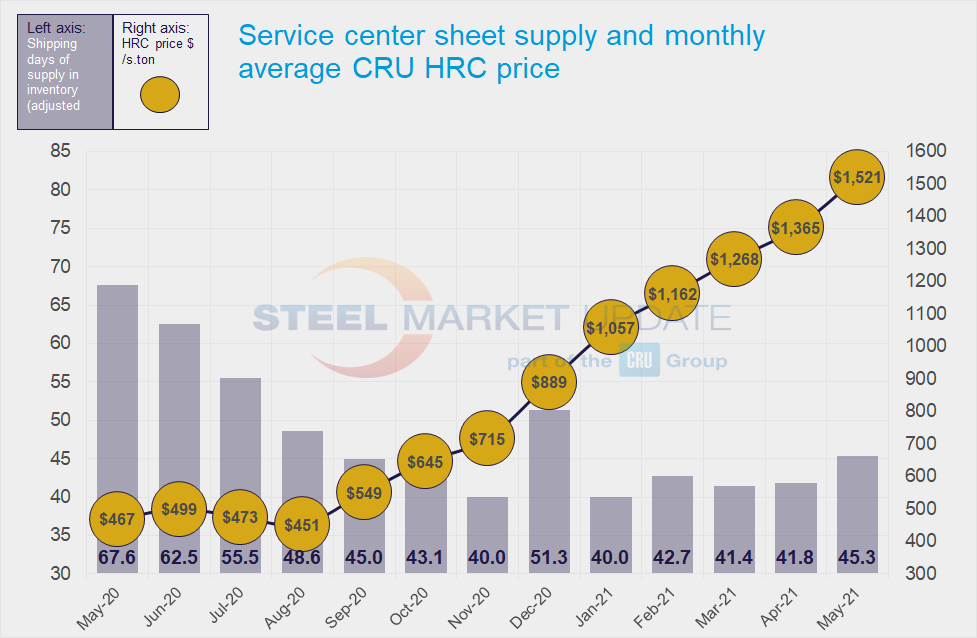SMU Data and Models

Service Center Shipments and Inventories Report for May
Written by Estelle Tran
June 15, 2021
Flat Rolled = 45.3 Shipping Days of Supply
Plate = 45.2 Shipping Days of Supply
Flat Rolled
U.S. service center flat rolled inventories grew significantly in May as mills caught up on deliveries and intake increased. At the end of May, service centers carried 45.3 shipping days of supply on an adjusted basis, up from 41.8 in April. SMU data showed inventories represented 2.27 months of supply in May, compared to 1.99 in April.
Though inventories notably picked up in May, they were significantly below normal levels. In May 2019, service centers carried 55.6 shipping days of flat rolled supply.
Shipments were down about 5% month on month, which can be attributed to May having 20 shipping days to April’s 21. The daily shipping rate in May was flat compared to April. Historically, May has been the month when supply has been tightest when compared to outbound shipments.
The percentage of flat rolled inventory on order may have peaked in April, as on-order volumes eased back in May.
SMU’s latest lead time survey published June 10 showed mill HRC lead times at 10.63 weeks; this was the third consecutive survey with lead times over 10 weeks. Anecdotally, however, we have heard that mills have been catching up on orders, allowing customers to max out on their contract volumes. We have also heard that there have been some spot opportunities with shorter lead times than what has been advertised.
Service centers have in addition started to report some customer pushback against higher prices, which may be a sign that customers are not as desperate for material as they had been. Others continue to be able to pass on higher costs without issue.
On-order sheet volumes remain elevated along with extended mill lead times. But we expect the amount of material on order will fall through the summer as imports arrive.
May import licenses for carbon and alloy flat rolled products reached the highest level seen so far this year with 917,000 metric tonnes, according to Department of Commerce data. U.S. flat rolled imports from Jan-May 2020 totaled 3.23 million tonnes. Jan-May flat rolled imports in 2021 might total 3.85 million tonnes based on May license data and April preliminary import data–or a 19% year-on-year increase. Imports are expected to remain elevated through the summer, which will help to fill supply chains and return service center inventories to normal levels.


Plate
Service center plate inventories also started to build in May, though plate shipments dropped more than sheet. At the end of May, service centers’ plate supply reached 45.2 shipping days of supply on an adjusted basis, up from 42.8 in April. Plate inventories represented 2.26 months of supply in May, up from 2.04 in April.
Shipments decreased 9% month on month, though contacts have reported seeing service centers and fabricators unable to get all the steel they need. The latest SMU survey reported plate mill lead times at 9.7 weeks, up from 9.43 weeks two weeks prior. Buyers are still reporting delays.
With inventories still lean for plate, on-order volumes have been rising.
Prices continue to rise for plate and are expected to increase more with scrap and flat rolled prices. With higher prices and extended lead times, intertrade among service centers remains the norm as centers seek to fill holes for certain products. Market contacts reported cautious optimism on increasing numbers of projects to quote, rising prices, and more demand from the heavy equipment, wind, construction and energy sectors


Estelle Tran
Read more from Estelle TranLatest in SMU Data and Models

SMU Survey: Buyers’ Sentiment rebounds from multi-year low
Both of SMU’s Steel Buyers’ Sentiment Indices edged higher this week. Current Sentiment rebounded from a near five-year low, while Future Sentiment rose to a two-month high

SMU flat-rolled market survey results now available
SMU’s latest steel buyers market survey results are now available on our website to all premium members.

SMU Survey: Sheet lead times pull back after early-June blip, plate holds
Following the uptick seen two weeks ago, lead times eased this week for all four sheet products tracked by SMU, while plate lead times held steady, according to this week’s market survey.

SMU Survey: Pricing power abruptly shifts to steel buyers
The majority of steel buyers responding to our latest market survey say domestic mills are more willing to talk price on sheet and plate products than they were earlier this month. Sheet negotiation rates rebounded across the board compared to early June, while our plate negotiation rate hit a full 100%.

Service centers: Mill orders down marginally in May
SMU’s Mill Order Index (MOI) declined for a third straight month in May, but only marginally.
